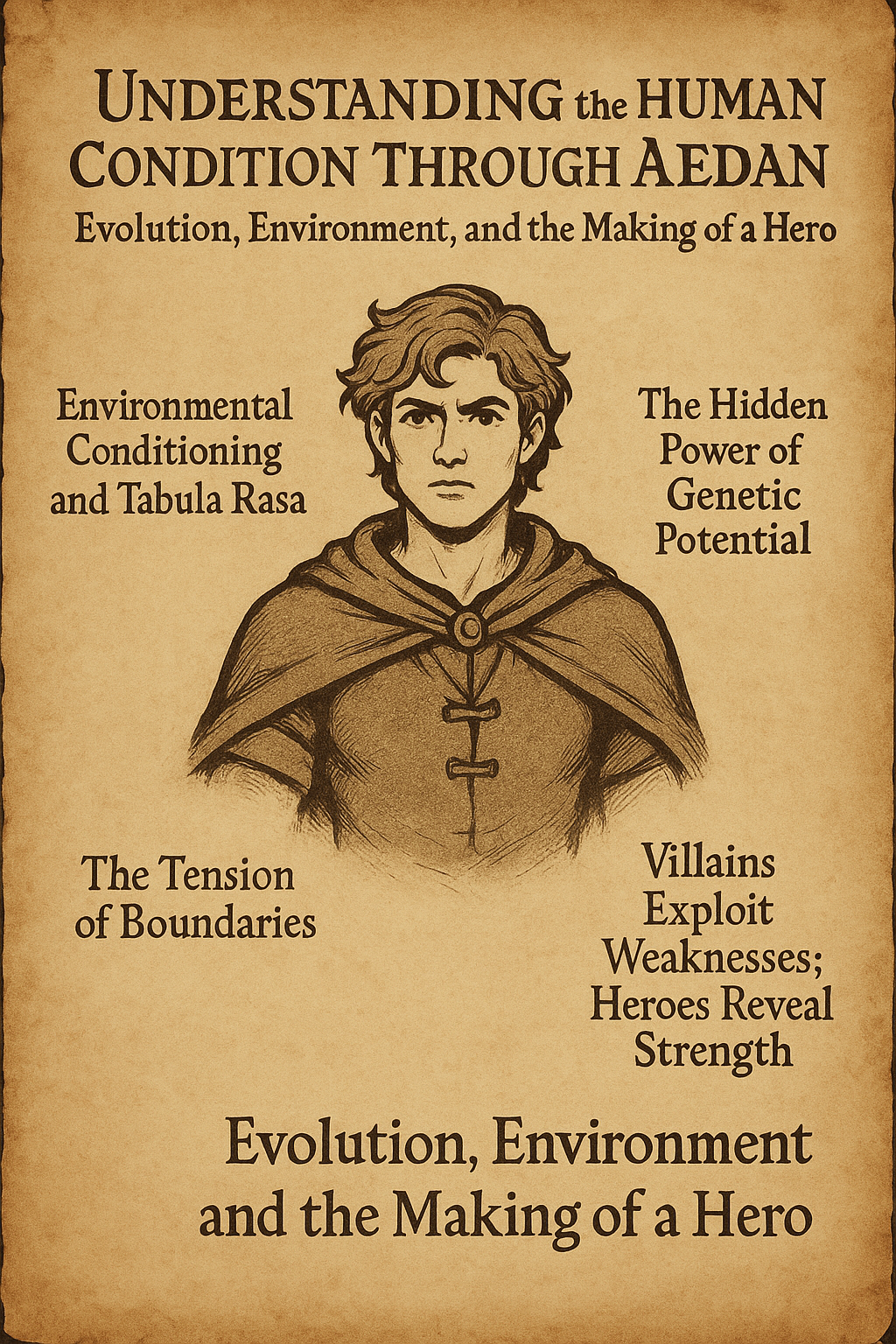To write powerful heroes and formidable villains, an author must understand life itself—its evolution, its forces, and its frailties. In Manah Wars: Glimmer in the Darkness, Aedan is not simply a character; he is a vessel through which the philosophical interplay of nature, nurture, and the soul is explored. His journey allows us to examine how environmental conditioning, the blank slate of tabula rasa, genetic potential, and even epigenetics shape the trajectory of a character’s arc—and how the ability to establish or lose personal boundaries defines the line between hero and villain.
Understanding the Human Condition Through Aedan: Evolution, Environment, and the Making of a Hero

Understanding the Human Condition Through Aedan: Evolution, Environment, and the Making of a Hero
Introduction
To write powerful heroes and formidable villains, an author must understand life itself—its evolution, its forces, and its frailties. In Manah Wars: Glimmer in the Darkness, Aedan is not simply a character; he is a vessel through which the philosophical interplay of nature, nurture, and the soul is explored. His journey allows us to examine how environmental conditioning, the blank slate of tabula rasa, genetic potential, and even epigenetics shape the trajectory of a character’s arc—and how the ability to establish or lose personal boundaries defines the line between hero and villain.
Environmental Conditioning and Tabula Rasa in Alteria
Aedan is the perfect embodiment of Locke’s tabula rasa. Raised by the Sa’ami, a forest-dwelling tribe of small, nimble people, Aedan grows up thinking he is one of them. His worldview, moral compass, and emotional instincts are shaped entirely by this upbringing. The nurture of the Sa’ami environment crafts in him humility, resourcefulness, and a deep sense of loyalty—even when he later learns he is not Sa’ami by blood.
This cultural and emotional imprinting underscores the power of environmental conditioning. When Aedan is pulled from this world and learns of his human origins and latent power, he feels betrayed—but the nurturing foundation of the Sa’ami keeps him grounded. He is proof that where we begin shapes how we walk, even when the path shifts beneath our feet.
The Hidden Power of Genetic Potential
Though raised in simplicity, Aedan is not simple. A letter from his deceased mother reveals he holds immense, world-altering power. His parents, fearing this power would draw evil, chose to raise him in secret. This speaks to a potent metaphor: no matter how peaceful one’s upbringing, genetic forces may lie dormant, waiting to emerge.
Aedan's transformation through the narrative reflects a kind of epigenetic awakening—environmental triggers, trauma, and stress unlocking traits hidden within his nature. His immense potential is not just magic or might, but the capacity to rise in moments of moral crisis.
The Tension of Boundaries: Between Strength and Vulnerability
Aedan is repeatedly tested in his ability to define and defend personal boundaries—whether refusing to defer to General Uriah’s bullying, enduring betrayal by his own queen, or submitting himself to fate when it seems the only option for survival. These trials push against his internal sense of self. Yet he holds fast. He is not without fear or anger, but he chooses when and how to show them.
This illustrates a vital truth for character building: strong characters do not lack boundaries—they evolve them. Aedan’s strength lies not in his raw power, but in his moral lines. When villains—like Count Pluto or Queen Maya—attempt to manipulate him, Aedan’s resistance lies in his internal compass, not just his physical will.
Villains Exploit Weaknesses; Heroes Reveal Strength
Villains in Glimmer in the Darkness—from the insidious Count Pluto to the fractured trust of Queen Maya—operate by exploiting weakness. Count Pluto offers Aedan freedom in exchange for loyalty, knowing full well Aedan is desperate. Maya herself uses state power to imprison him unjustly, doubting his allegiance after all he has sacrificed.
But the story subverts expectation: Aedan does not become vengeful. He endures. And in doing so, his enemies reveal themselves—not just as powerful, but as afraid. Pluto fears losing control. Maya fears the truth. Maleh fears death and uses dark phylacteries to avoid it. Aedan, by contrast, accepts weakness and loss, and turns them into strength.
The Hero’s Journey Through the Lens of Biology and Identity
Aedan’s arc reflects Campbell’s monomyth, but infused with the intricacies of heredity and conditioning. He begins in the Ordinary World—Sylvinar and the Sa’ami forests. He receives his call to adventure through letters, dreams, and trials. He refuses at first, but is eventually thrust into transformation.
What elevates Glimmer in the Darkness is its realism within fantasy. Aedan’s return is not triumphant. It is uncertain, painful. He doesn't reclaim a throne or slay a dragon in glory—he survives. He chooses again. That is evolution: not domination, but transformation through adaptation.
Conclusion
Aedan’s story is not just an epic fantasy. It is a living discourse on what makes us human. Through him, Manah Wars interrogates the boundaries between destiny and choice, between biology and willpower, between nurture and nature.
In your own writing, ask yourself:
-
What environments have shaped your characters?
-
What lies dormant in their blood?
-
When are their boundaries tested?
-
Do they break? Or do they bend and reform?
The answers lie in life itself.
